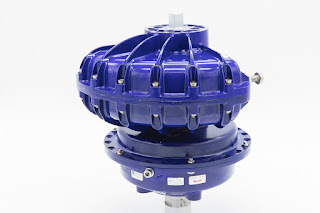 |
| Rotary vane actuator |
Quarter turn valves are widely used in industrial process automation. Their application is primarily for operations requiring fully open or fully closed valve trim positions, although some do provide modulating service. A rotation of the valve stem through a 90 degree arc will reposition quarter turn valve trim between open and closed positions. A rotary vane actuator is well suited for driving this type of valve, with its own 90 degree arc of movement.
A rotary vane actuator operates quarter turn valves, dampers and louvers. A pressure tight housing contains a movable vane which is sealed to the sides of the pressure chamber by means of a low friction gasket. Inlets into the chamber on opposing sides of the vane allow a controller to produce a pressure differential across the vane. The vane will move, in response to the pressure differential, in either direction. A shaft is connected to the vane and the vane acts like a lever to rotate the shaft as the vane is moved by fluid pressure. The torque produced by the actuator assembly is primarily dependent upon the applied fluid pressure.
Hydraulic rotary vane actuators have the ability to handle large amounts of fluid and dynamic motions, exhibiting also qualities of durability and compactness. Pneumatic vane actuators use plant air pressure as the motive force. Both types generally have few moving parts and require little regular maintenance. A variety of typical automation accessories and options are available to customize a unit for a particular application.


